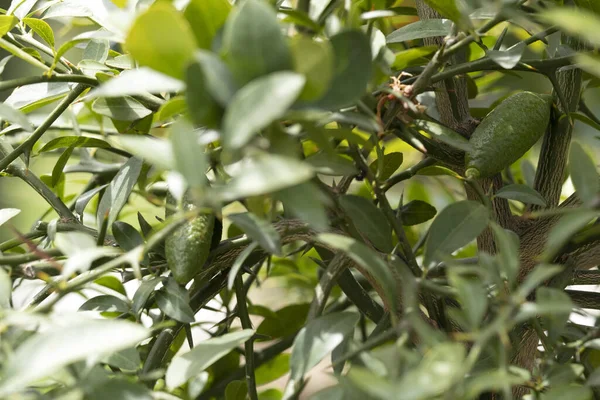Finger Lime - Botanical Information, Health and Various Uses
Welcome to our guide to finger limes (caviar limes). Here we delve into the botanical intricacies, growing methods, harvesting tips, culinary and non-culinary applications, cultural significance, and health benefits of finger limes. This information is intended to provide you with a wealth of new knowledge about these unique citrus trees, helping you understand and appreciate their true value.

Finger Lime - Botanical Facts and Properties
A unique citrus gem
The finger lime, scientifically known as Citrus australasica, is a unique member of the citrus family. Native to the rainforests of Australia, it is often referred to as the "caviar lime" due to its unique pearl-like fruit (vials). These trees, which can reach heights of 2 to 5 meters, bear elongated, finger-shaped fruits that are usually 5 to 10 centimeters long. The rind of the fruit varies in color, from green to brown to purple, depending on the variety.
Leaves and flowers
The leaves of the finger lime tree are small and shiny, elliptical in shape, and emit a fragrant citrus scent when crushed. The tree produces small, white flowers with a pleasant aroma, which usually bloom in spring.
Climatic preferences
Finger lime trees thrive in subtropical and tropical climates. They are sensitive to cold temperatures, with an ideal range between 10° and 30°. These trees require full sun exposure for optimal growth and fruit production.
pollination
Finger lime trees are mostly self-pollinating, but cross-pollination can improve fruit production. Bees and other pollinators are key to improving fruit development, so planting other citrus varieties nearby can be beneficial.
Cultivation, growing and care of finger lime trees
When planting caviar lime trees, it is important to choose a location with good drainage. The soil pH should ideally be between 5.5 and 7.0, slightly acidic to neutral. Make sure the planting hole is large enough to accommodate the root system without crowding.
Site selection and soil preparation
Choose a location that receives full sun and is protected from strong winds, as these conditions are essential for fruit development. Adequate sunlight ensures that the tree's photosynthesis process functions optimally.
Watering, fertilizing and mulching
Proper watering is essential for finger lime trees. These citrus trees need consistent moisture to thrive. Water them deeply and regularly, but avoid overwatering. Fertilize the tree with a balanced citrus-specific fertilizer during the growing season.
Mulching helps retain soil moisture and suppresses weeds around the base of the tree. It is recommended to apply mulch 5-10 centimeters deep, making sure not to touch the trunk.
Pruning and pests
Pruning is essential to maintain the tree's shape and encourage air circulation. Remove dead or diseased branches, and prune back any new trunks (called "suckers") that try to grow from the bottom of the tree.
Finger lime trees can be susceptible to pests such as aphids. Regular inspection and application of organic pest control methods can help protect the tree.
Cultivation, growing and care of finger lime trees
Best practices for harvesting
Finger limes are usually ready to pick in late summer to early fall. Gently twist or cut the fruit from the tree when it reaches the desired size and color. Pick carefully to avoid damage.
Culinary uses
Finger limes are a culinary delight, with their caviar-like piths adding a burst of tart flavor and texture to a variety of dishes. They are often used as a garnish for seafood, salads, or desserts.
Non-culinary applications
Beyond the kitchen, they find applications in cosmetics and skin care. Their high vitamin C content makes them a valuable ingredient in skin care products, contributing to healthy skin.
Cultural and symbolic significance of the finger lime tree
The fruit often has symbolic meaning in different cultures. In Australian Aboriginal mythology, finger limes are revered as a source of nourishment and are associated with the Dreamtime.
Finger limes are considered a symbol of abundance and fertility in many indigenous cultures. They are often used in ceremonies and rituals to celebrate the blessings of life.
Finger Lime - Health Benefits
Finger limes are a treasure trove of nutrients. They are rich in vitamin C, folate, potassium, and fiber. These nutrients contribute to a healthy immune system, bone health, and digestive well-being.
Consuming finger limes can help with weight management, as their high fiber content promotes satiety. They also support heart health and reduce the risk of chronic disease due to their antioxidant properties.
Finger Lime - Did you know?
The finger lime tree can bear fruit year-round, making it a continuous source of fresh fruit.
The unique caviar-like appearance of finger lime pearls has earned them a place of honor in gourmet kitchens around the world.
Indigenous Australians have used them for centuries, not only for their taste but also for their medicinal properties.
Summary
In conclusion, finger limes are unique citrus trees that thrive in subtropical and tropical climates. Proper care, including choosing the right planting site, adequate watering, and close attention, ensures a bountiful harvest. Their culinary and non-culinary applications, rich cultural significance, and incredible health benefits make them a valuable addition to any garden. We hope this comprehensive guide has provided you with the insights you need to appreciate and cultivate these extraordinary trees.

_page-0001_edited.png)